Computer music development
Computers are inextricably linked with our lives, they are used in all kinds of areas of activity and human life, expand capabilities, greatly simplify the work. With their help, people invent new technologies, make progress in science, learn space and make many useful, important discoveries. Similarly, the use of computer technology has affected the development of art. In particular, the emergence of electronic music.

Raymond Kurzweil, a young American engineer, inventor, and futurologist, has an innovative design approach. He created a reading machine for the blind. It was based on a method that allows the device to read almost any printed document. In computer science classes, Kurzweil faced a rather difficult task from the field of artificial intelligence. He was trying to figure out how to program a computer so that he could catch commonality in different versions of the same object? The ability to recognize images, among other things, gave the computer the ability to recognize printed letters, regardless of font.
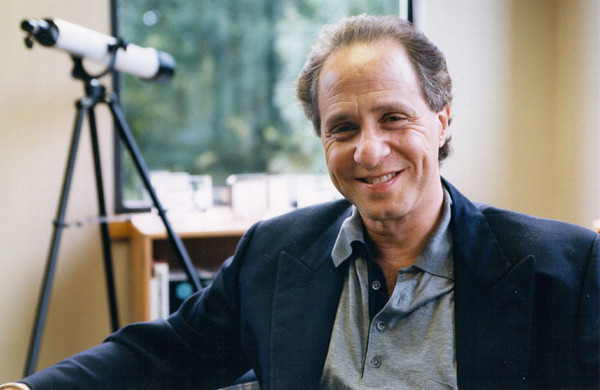
Raymond Kurzweil
At that time, a letter recognition system already existed, which was used since the late 50s, when banks began to use "magnetic ink" to write numbers on personal checks. But only stylized fonts were suitable for working with the reader. From a universal text reading system, recognition of up to 300 of the most common fonts of various shapes and sizes was required, regardless of texture, color of paper, spots, blots, etc.
In 1973, Kurzweil began developing a reading machine. He assembled a team of specialists from Harvard University, choosing all possible fields of knowledge - from programming and mechanics to philology and pedagogy. The formed company lacked funds, young developers huddled in a dormitory. Nevertheless, after a year and a half, the public was presented with a working model of a reading machine. A year later, the first commercial model went on sale, immediately gaining universal recognition.

Personal version of the reading machine
One of the first owners of the car was the famous rock musician and singer Stevie Wonder, who was blind from birth. He was so impressed with the development that he personally visited the inventor. Friendship began between them, which served as a start for new inventions. Wonder posed a more difficult task for Kurzweil and introduced a number of useful suggestions and corrections for improving the reading machine.
In 1982, Wonder proposed inventing another device - an electronic instrument that could accurately reproduce the sounds of a piano or any other musical instrument. Existing electronic music synthesizers seemed to the musician not perfect in terms of beauty and complexity of sound. And despite the fact that Kurzweil was little interested in music, he decided to try to make an innovative device.

Stevie Wonder
Kurzweil opened a new company - Kurzweil Music Systems (KMS), and Stevie Wonder became her music consultant. Exactly two years later, the company created the world's first digital synthesizer Kurzweil250 - which is a kind of specialized computer.
Kurzweil250 stored in its memory digitized fragments of sounds of live instruments, and also had a keyboard unusually sensitive to the speed of pressing keys. The synthesizer had an exceptionally high sound synthesis, which even at test auditions, professional pianists could hardly distinguish the difference in sound between the device and the concert grand piano. But the most amazing was the synthesizer architecture. In fact, it performed the simple functions of a tunable digital signal processor, which allowed extremely fine control of all parameters of the virtual sound path.

Synthesizer Kurzweil250
Very quickly, KMS became the leader in digital synthesis, and the Kurzweil250 almost completely replaced analog synthesizers. Kurzweil’s invention has become popular and sales of digital synthesizers have grown five-fold over the past few years. The company developed new models of tools, while improving quality and lowering prices. Of course, competing large firms immediately activated, switching to digital synthesis. Nevertheless, the Kurzweil synthesizers have firmly taken a leading position in the ratings of musicians' ratings.

Wonder and Kurzweil behind the Kurzweil synthesizer
In the 50s, the first programmable synthesizers appeared - RCA Mark I and Mark II. They were developed and created by RCA Princeton Lab engineers Harry Olson and Herbert Belar. The developers were based on the principles and laws of the fundamental theory of information transfer described in the article by mathematician, engineer and cryptographer Claude Shannon (“Mathematical Communication Theory”). In 1950, they released their research report, in which they proposed using mathematical methods to create music.
Outwardly, RCA Mark synthesizers were like computers of that time - electronic lamps and wires occupied an entire room. But according to the principle of action, they rather resembled an electronic version of a “mechanical piano” controlled by binary codes punched on a wide paper paper tape. Like a computer, the synthesizer used a roll punched tape as memory, which stored information about the settings of electronic blocks at the time of extraction of a sound.
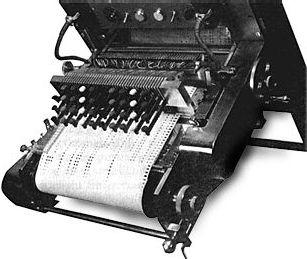
The RCA Mark I synthesizer was shown to the public in 1955.
RCA Mark I totaled 12 tube oscillators (one for each note of an octave), and a huge number of frequency filters, dividers, modulators, resonators, which allowed in theory to receive an infinite number of sounds. In practice, he easily synthesized previously unheard of unearthly sounds, but could not imitate, for example, smooth violin or trombone transitions from note to note.
RCA Mark I was followed by Mark II with a doubled number of oscillators, four-note polyphony and using magnetic tape to store information.

Composers: Milton Babbitt, Peter Mosey, Vladimir Usachevsky on the background of the RCA Mark II synthesizer (1958)
One of the most famous works created on RCA Mark II was the work of Charles Vuorinen's “Time Enconium” (for which the composer received the Pulitzer Prize in 1970). Mark II could theoretically be mass-produced for electronic music studios, if not for its size and price.
The Soviet inventor and colonel of artillery, Yevgeny A. Usachev, in 1958 developed the first Soviet synthesizer (photoelectronic optical musical instrument) ANS. The instrument was named in honor of the Russian composer Alexander Nikolaevich Scriabin. It is noteworthy that the developer used synthesis technologies that are completely different from American ones. In the ANS, the method of photo-optical synthesis was used and very interesting possibilities were presented, such as storing information on removable media.
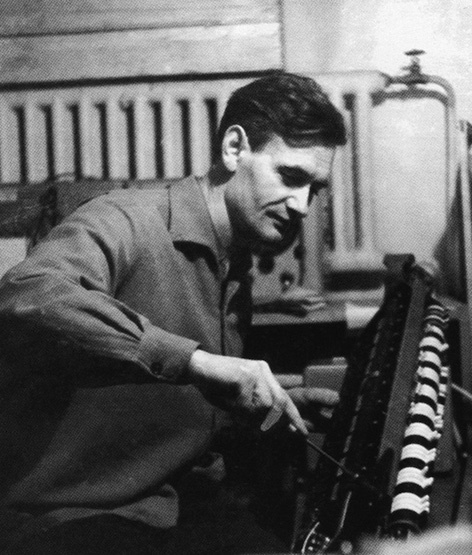
Murzin in the process of working on the ANS synthesizer
The principle of operation of the device was based on the method of optical sound recording used in cinema. In optical recording, the sound signal controlled the luminous flux, creating a lit strip of variable width or density on the film. To reproduce the optical phonogram, a light source and a photocell were used, between which a film was stretched. A change in the brightness of the light flux when passing through a film causes a change in the current through the photocell. The received electrical signal is amplified and reproduced through the speaker.
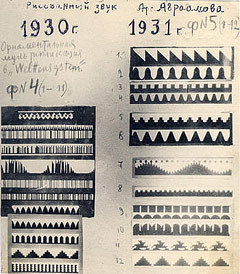
An example of recording sounds on the ANS
The ANS was a bit of RAM, making it especially similar to modern synthesizers. The synthesizer was appreciated by the composers of that time. To the sound of the ANS on the screen, the audience watched Eva Braun and Hitler kill themselves in Yuri Ozerov's film epic “Liberation” (1972). This instrument gave a sound characterization to the heroes of the Soviet full-length cartoon “Mowgli”. Together with composers Sofia Gubaidulina, Alfred Schnittke, Edison Denisov and others, a whole record was recorded, where they, using the ANS synthesizer, found new approaches to creating cartoons. But no other synthesizer existing then was able to recreate such a sound palette.
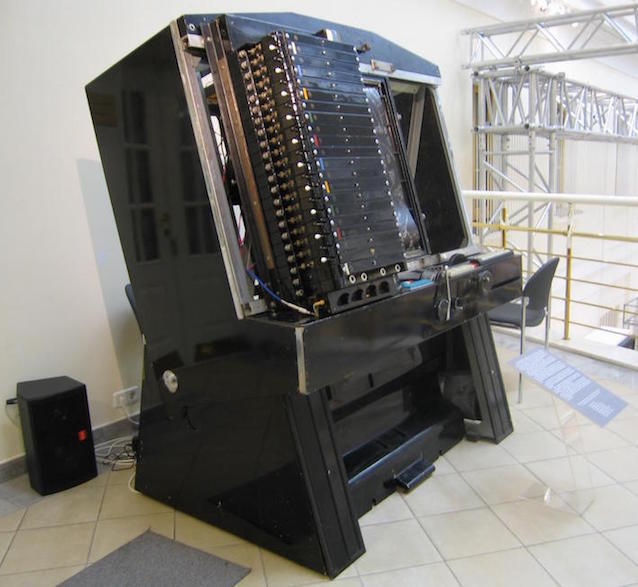
Synthesizer ANS is in the Glinka Museum, Moscow
Electronic music created by analog synthesizers was gradually introduced into popular culture. And along with this, experiments were conducted using digital computers for such purposes.
In the late 50s, American engineer Max Matthews was engaged in the study of artificial voice synthesis. He was fond of playing the violin and could appreciate the possibility of applying the acquired computer knowledge in music.
In 1960, together with a development team, Matthews created the world's first computer music program, MUSIC-N, through which a computer synthesized various sounds. The debut program was the play Variations in Tone, performed only a few times in front of a relatively narrow audience.
The Matthews team began to improve the MUSIC-N. In 1961, they recorded a disc entitled “The Music of Mathematics” and sent it out by an authoritative musician for quality assessment. But this innovation did not cause much enthusiasm among the music community.

Max Matthews at work
Matthews went further and in 1969 created the MUSIC-V program, which turned a large universal computer (such as IBM's System / 360) into a musical instrument. The program composed a piece of music in two stages. First, it was necessary to make a mathematical description of the characteristics of the instruments that the computer needed to simulate. After that, a score was recorded connecting the parts of simulated instruments. Further, all information was translated into binary numbers representing the frequencies and amplitudes of musical sounds. The computer was engaged in processing the obtained numbers, receiving new ones that made up the sound file recorded on magnetic tape. The record could be modified. The musician had the opportunity to listen to his composition.
Although the system was notable for power, it worked rather slowly. For example, to synthesize a musical phrase lasting 1 second, a huge number of calculations were performed. The composer needed to enter all the parameters of his composition into a computer. After which he had to wait (sometimes for hours) until the magnetic recording was ready for listening.

Laboratory bell
Not everything in the work of Matthews went smoothly, there were difficulties (slowness of work, clarity of sound, etc.) with which the development team was not always able to cope. Despite this, pioneering experiments in the music-computer field attracted the attention of young composers. In the 60s, Matthews was increasingly visited by musicians. Using the MUSIC-V program did not require the supply of sound generated by analog devices, and the composers opened up unlimited scope for creativity. They could invent anything.
One of the significant achievements was the MUSIC4 software package for musical synthesis. This program was an extended version of previous designs written by Matthews to play music by direct digital computing. The recordings could be heard by converting the samples into sound using a digital-to-analog converter (DAC).
MUSIC4 allowed the programmer to enter the score (music edition) as a text file. There were tips with the characteristic "musical instrument", which is a software algorithm. Some tools were provided in the software package, but the programmer could add new ones using Fortran code.

Matthews as a professor at Stanford University (1988)
By design, the package was not intended for direct generation of music, unlike modern portable electronic keyboard instruments. Instead, all songs or musical parts were encoded and processed as a digital file on a disc or tape containing a stream of samples. Prior to the advent of the cost-effective digital sound recording mechanism in the late 80s, samples were typically sent to the DAC and recorded on an analog tape.
Subsequently, MUSIC4 was transformed by Godfrey Wingham and Hubert Howe into MUSIC4B, and then into MUSIC4BF (the computer program CSound was developed on its basis).
Another pioneer in electronic music was the American composer John Chowning. He was inspired by the work of Matthews and delved into the study of computer technology. The composer has become a frequent guest at Stanford University's artificial intelligence lab. During the experiments, Chowning discovered that from two simple signals (one of which was the carrier, and its frequency was modulated by the second signal), it was possible to create fairly fast vibratos that reproduced complex harmonic or inharmonic tones. The algorithm is called “frequency modulation synthesis” or FM synthesis (1967).
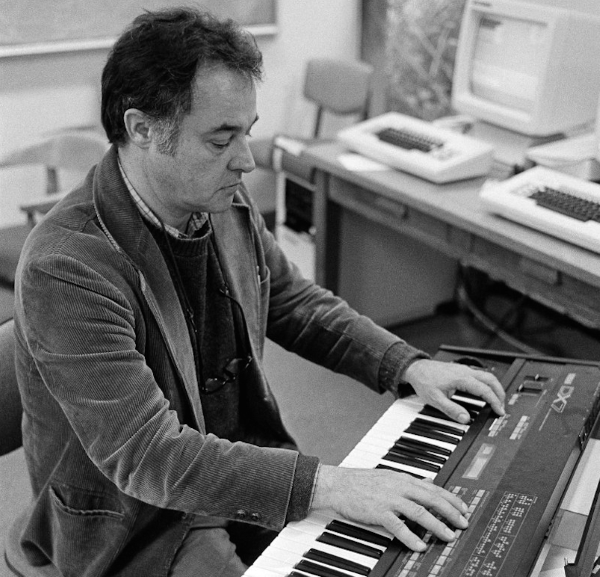
John Chowning
The FM frequency modulation technique was taken by the composer from the field of radio reception. Using a computer implementation, it allowed the synthesis of extremely complex dynamic spectra that could be controlled using simple and cheap means. The creation of FM synthesis was of great importance for musicians, opening them a new world of variable changes and sound settings. The synthesis could be used to produce high-precision digital replications of real instruments.
Turenas electronic composition
In 1972, the first Turenas electronic composition was created, which included a sound illusion. For the first time, an advanced FM synthesis technique was used, along with the movement of sound in the space around the listener (360 degrees).
FM synthesis has been used in many electronic musical instruments. In 1974, Yamaha, a Japanese firm of analog electronic synthesizers, praised the possibilities of digital FM synthesis and even acquired a license to use the development. In 1983, the first model of the DX-7 synthesizer was released, which used FM synthesis. DX-7 had 6 tone generators (operators), which could be connected using 32 methods (algorithms). Possessing the corresponding knowledge in the field of FM synthesis directly in the synthesizer, it was possible to create new sounds. The DX-7 also had a panel for connecting a memory cartridge - this allowed to expand the original number of sounds. The company's specialists have invested a lot of effort and money to make the synthesizer as high-tech as possible.
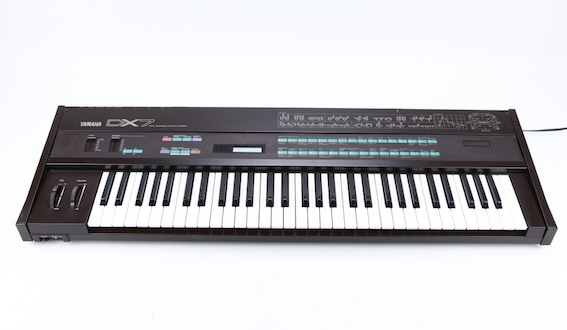
Yamaha DX7 Synthesizer
Yamaha continued to produce synthesizers, transforming and improving models, they became more compact, versatile and cheaper. Endowed with more memory and more sophisticated software, digital music synthesizers became specialized computers.
In the late 60s, American inventor and entrepreneur Robert Moog developed the world's first commercially successful keyboard synthesizer Moog. He also became famous for having independently assembled theremin (development of the Soviet inventor Lev Sergeyevich Theremin).
Mug began developing his synthesizer back at Princeton Center at Columbia University. Together with composer Herbert Deutsch, he created a voltage-controlled electronic generator, as well as an ADSR envelope generator and other modules. After that, additional chains were added and the synthesizer was ready for production.

Robert Moog on the background of a synthesizer
In 1964, a congress of engineers and scientists working with professional musical equipment was held, where the modular voltage-controlled keyboard synthesizer Moog was presented. In 1969, Mug received a patent for the low-pass filter he invented.
The tool was not in great demand. The thing is that few people had an idea of how most of the synthesizer modules work. And therefore, the first buyers were composers-experimenters, as well as universities that have the technical ability to understand the synthesizer. Yes, and the Moog synthesizer was quite expensive (from $ 30,000).
The synthesizer overtook unexpected success in 1968 when Wendy Carlos (once Walter Carlos) released his album Switched on Bach, a collection of classic pieces played on the Moog modular synthesizer. The album did not leave anyone indifferent. Experimenting musicians and avant-garde composers saw the use of a synthesizer in the album only as a simulator of real instruments. “Switched on Bach” was incredibly liked and sold out very quickly. And of course, he glorified the Moog synthesizer.
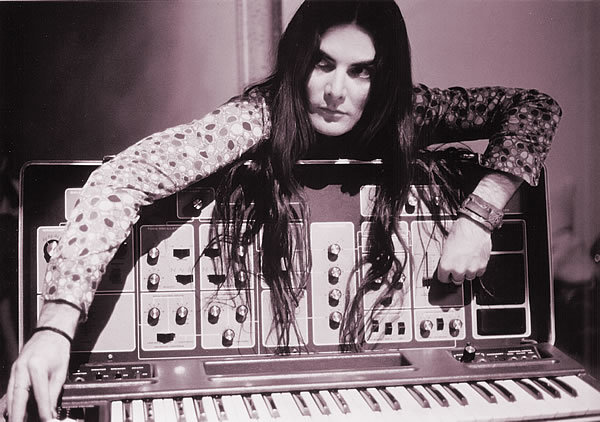
Wendy Carlos
In subsequent years, the company Muga created other models of synthesizers, also called Moog. Basically they were called “Modular Systems”.
In the 80s, the joint efforts of choreographers and computer scientists helped develop a system that captures the main steps and movements in the dance. Tom Calvert, a kinesiologist and biomedical technician, was one of the first to start experimenting by combining computer graphics with a choreographic notation system. He fixed resistors on himself to count and digitize his own movements.
At the first stages, the program simulated a dance on the screen using a stick figure, executing at a real pace the modified choreographic notation commands that were entered on the keyboard. But with the advent of more powerful computer resources, the animated capabilities have expanded. The image on the screen appeared depth, sharpness. It was possible to change the pose of the figure by simply entering commands on the keyboard, such as “turn your head”, “raise your hand”, etc. More complex combinations of movements required the input of a whole set of commands.

Movements on computer screen
Calvert continued to work on improving the system. He wanted to make sure that you could do without a keyboard to control movements. To do this, they used goniometers that were attached to the joints of the dancer. The devices sent electrical signals to the computer through an analog-to-digital converter, causing the figure on the screen to repeat the dancer's poses.
In fact, the system developed by Calvert was very similar to modern motion capture, the technology of which is widely used in the gaming industry, animation and for creating special effects.

Raymond Kurzweil, a young American engineer, inventor, and futurologist, has an innovative design approach. He created a reading machine for the blind. It was based on a method that allows the device to read almost any printed document. In computer science classes, Kurzweil faced a rather difficult task from the field of artificial intelligence. He was trying to figure out how to program a computer so that he could catch commonality in different versions of the same object? The ability to recognize images, among other things, gave the computer the ability to recognize printed letters, regardless of font.

Raymond Kurzweil
At that time, a letter recognition system already existed, which was used since the late 50s, when banks began to use "magnetic ink" to write numbers on personal checks. But only stylized fonts were suitable for working with the reader. From a universal text reading system, recognition of up to 300 of the most common fonts of various shapes and sizes was required, regardless of texture, color of paper, spots, blots, etc.
In 1973, Kurzweil began developing a reading machine. He assembled a team of specialists from Harvard University, choosing all possible fields of knowledge - from programming and mechanics to philology and pedagogy. The formed company lacked funds, young developers huddled in a dormitory. Nevertheless, after a year and a half, the public was presented with a working model of a reading machine. A year later, the first commercial model went on sale, immediately gaining universal recognition.

Personal version of the reading machine
Inspired by music
One of the first owners of the car was the famous rock musician and singer Stevie Wonder, who was blind from birth. He was so impressed with the development that he personally visited the inventor. Friendship began between them, which served as a start for new inventions. Wonder posed a more difficult task for Kurzweil and introduced a number of useful suggestions and corrections for improving the reading machine.
In 1982, Wonder proposed inventing another device - an electronic instrument that could accurately reproduce the sounds of a piano or any other musical instrument. Existing electronic music synthesizers seemed to the musician not perfect in terms of beauty and complexity of sound. And despite the fact that Kurzweil was little interested in music, he decided to try to make an innovative device.

Stevie Wonder
Kurzweil opened a new company - Kurzweil Music Systems (KMS), and Stevie Wonder became her music consultant. Exactly two years later, the company created the world's first digital synthesizer Kurzweil250 - which is a kind of specialized computer.
Kurzweil250 stored in its memory digitized fragments of sounds of live instruments, and also had a keyboard unusually sensitive to the speed of pressing keys. The synthesizer had an exceptionally high sound synthesis, which even at test auditions, professional pianists could hardly distinguish the difference in sound between the device and the concert grand piano. But the most amazing was the synthesizer architecture. In fact, it performed the simple functions of a tunable digital signal processor, which allowed extremely fine control of all parameters of the virtual sound path.

Synthesizer Kurzweil250
Very quickly, KMS became the leader in digital synthesis, and the Kurzweil250 almost completely replaced analog synthesizers. Kurzweil’s invention has become popular and sales of digital synthesizers have grown five-fold over the past few years. The company developed new models of tools, while improving quality and lowering prices. Of course, competing large firms immediately activated, switching to digital synthesis. Nevertheless, the Kurzweil synthesizers have firmly taken a leading position in the ratings of musicians' ratings.

Wonder and Kurzweil behind the Kurzweil synthesizer
History of the development of electronic musical instruments
The first electric musical instrument was designed by an American engineer Tadeusz Cahill in 1897. He received the name telarmonium. The instrument weighed 200 tons and reached a length of 19 m. It worked on the basis of electric generators and tonal wheels. An audio signal of sound frequency in it was created using 145 special dynamo machines. It was transmitted over the telephone network to apartments, hotels and restaurants, where it was played through megaphones connected to a telephone. The amplitude range was in the region of 40-4000 Hz.

The telarmonium was worth a fortune. The principles underlying it have not lost their strength and have been applied for several decades.

The telarmonium was worth a fortune. The principles underlying it have not lost their strength and have been applied for several decades.
Synthesizer RCA Mark
In the 50s, the first programmable synthesizers appeared - RCA Mark I and Mark II. They were developed and created by RCA Princeton Lab engineers Harry Olson and Herbert Belar. The developers were based on the principles and laws of the fundamental theory of information transfer described in the article by mathematician, engineer and cryptographer Claude Shannon (“Mathematical Communication Theory”). In 1950, they released their research report, in which they proposed using mathematical methods to create music.
Outwardly, RCA Mark synthesizers were like computers of that time - electronic lamps and wires occupied an entire room. But according to the principle of action, they rather resembled an electronic version of a “mechanical piano” controlled by binary codes punched on a wide paper paper tape. Like a computer, the synthesizer used a roll punched tape as memory, which stored information about the settings of electronic blocks at the time of extraction of a sound.

The RCA Mark I synthesizer was shown to the public in 1955.
RCA Mark I totaled 12 tube oscillators (one for each note of an octave), and a huge number of frequency filters, dividers, modulators, resonators, which allowed in theory to receive an infinite number of sounds. In practice, he easily synthesized previously unheard of unearthly sounds, but could not imitate, for example, smooth violin or trombone transitions from note to note.
RCA Mark I was followed by Mark II with a doubled number of oscillators, four-note polyphony and using magnetic tape to store information.

Composers: Milton Babbitt, Peter Mosey, Vladimir Usachevsky on the background of the RCA Mark II synthesizer (1958)
One of the most famous works created on RCA Mark II was the work of Charles Vuorinen's “Time Enconium” (for which the composer received the Pulitzer Prize in 1970). Mark II could theoretically be mass-produced for electronic music studios, if not for its size and price.
Soviet synthesizer ANS
The Soviet inventor and colonel of artillery, Yevgeny A. Usachev, in 1958 developed the first Soviet synthesizer (photoelectronic optical musical instrument) ANS. The instrument was named in honor of the Russian composer Alexander Nikolaevich Scriabin. It is noteworthy that the developer used synthesis technologies that are completely different from American ones. In the ANS, the method of photo-optical synthesis was used and very interesting possibilities were presented, such as storing information on removable media.

Murzin in the process of working on the ANS synthesizer
The principle of operation of the device was based on the method of optical sound recording used in cinema. In optical recording, the sound signal controlled the luminous flux, creating a lit strip of variable width or density on the film. To reproduce the optical phonogram, a light source and a photocell were used, between which a film was stretched. A change in the brightness of the light flux when passing through a film causes a change in the current through the photocell. The received electrical signal is amplified and reproduced through the speaker.

An example of recording sounds on the ANS
The ANS was a bit of RAM, making it especially similar to modern synthesizers. The synthesizer was appreciated by the composers of that time. To the sound of the ANS on the screen, the audience watched Eva Braun and Hitler kill themselves in Yuri Ozerov's film epic “Liberation” (1972). This instrument gave a sound characterization to the heroes of the Soviet full-length cartoon “Mowgli”. Together with composers Sofia Gubaidulina, Alfred Schnittke, Edison Denisov and others, a whole record was recorded, where they, using the ANS synthesizer, found new approaches to creating cartoons. But no other synthesizer existing then was able to recreate such a sound palette.

Synthesizer ANS is in the Glinka Museum, Moscow
Math music
Electronic music created by analog synthesizers was gradually introduced into popular culture. And along with this, experiments were conducted using digital computers for such purposes.
In the late 50s, American engineer Max Matthews was engaged in the study of artificial voice synthesis. He was fond of playing the violin and could appreciate the possibility of applying the acquired computer knowledge in music.
In 1960, together with a development team, Matthews created the world's first computer music program, MUSIC-N, through which a computer synthesized various sounds. The debut program was the play Variations in Tone, performed only a few times in front of a relatively narrow audience.
The Matthews team began to improve the MUSIC-N. In 1961, they recorded a disc entitled “The Music of Mathematics” and sent it out by an authoritative musician for quality assessment. But this innovation did not cause much enthusiasm among the music community.

Max Matthews at work
Matthews went further and in 1969 created the MUSIC-V program, which turned a large universal computer (such as IBM's System / 360) into a musical instrument. The program composed a piece of music in two stages. First, it was necessary to make a mathematical description of the characteristics of the instruments that the computer needed to simulate. After that, a score was recorded connecting the parts of simulated instruments. Further, all information was translated into binary numbers representing the frequencies and amplitudes of musical sounds. The computer was engaged in processing the obtained numbers, receiving new ones that made up the sound file recorded on magnetic tape. The record could be modified. The musician had the opportunity to listen to his composition.
Although the system was notable for power, it worked rather slowly. For example, to synthesize a musical phrase lasting 1 second, a huge number of calculations were performed. The composer needed to enter all the parameters of his composition into a computer. After which he had to wait (sometimes for hours) until the magnetic recording was ready for listening.

Laboratory bell
Not everything in the work of Matthews went smoothly, there were difficulties (slowness of work, clarity of sound, etc.) with which the development team was not always able to cope. Despite this, pioneering experiments in the music-computer field attracted the attention of young composers. In the 60s, Matthews was increasingly visited by musicians. Using the MUSIC-V program did not require the supply of sound generated by analog devices, and the composers opened up unlimited scope for creativity. They could invent anything.
One of the significant achievements was the MUSIC4 software package for musical synthesis. This program was an extended version of previous designs written by Matthews to play music by direct digital computing. The recordings could be heard by converting the samples into sound using a digital-to-analog converter (DAC).
MUSIC4 allowed the programmer to enter the score (music edition) as a text file. There were tips with the characteristic "musical instrument", which is a software algorithm. Some tools were provided in the software package, but the programmer could add new ones using Fortran code.

Matthews as a professor at Stanford University (1988)
By design, the package was not intended for direct generation of music, unlike modern portable electronic keyboard instruments. Instead, all songs or musical parts were encoded and processed as a digital file on a disc or tape containing a stream of samples. Prior to the advent of the cost-effective digital sound recording mechanism in the late 80s, samples were typically sent to the DAC and recorded on an analog tape.
Subsequently, MUSIC4 was transformed by Godfrey Wingham and Hubert Howe into MUSIC4B, and then into MUSIC4BF (the computer program CSound was developed on its basis).
FM Chowning Synthesis
Another pioneer in electronic music was the American composer John Chowning. He was inspired by the work of Matthews and delved into the study of computer technology. The composer has become a frequent guest at Stanford University's artificial intelligence lab. During the experiments, Chowning discovered that from two simple signals (one of which was the carrier, and its frequency was modulated by the second signal), it was possible to create fairly fast vibratos that reproduced complex harmonic or inharmonic tones. The algorithm is called “frequency modulation synthesis” or FM synthesis (1967).

John Chowning
The FM frequency modulation technique was taken by the composer from the field of radio reception. Using a computer implementation, it allowed the synthesis of extremely complex dynamic spectra that could be controlled using simple and cheap means. The creation of FM synthesis was of great importance for musicians, opening them a new world of variable changes and sound settings. The synthesis could be used to produce high-precision digital replications of real instruments.
Turenas electronic composition
In 1972, the first Turenas electronic composition was created, which included a sound illusion. For the first time, an advanced FM synthesis technique was used, along with the movement of sound in the space around the listener (360 degrees).
FM synthesis has been used in many electronic musical instruments. In 1974, Yamaha, a Japanese firm of analog electronic synthesizers, praised the possibilities of digital FM synthesis and even acquired a license to use the development. In 1983, the first model of the DX-7 synthesizer was released, which used FM synthesis. DX-7 had 6 tone generators (operators), which could be connected using 32 methods (algorithms). Possessing the corresponding knowledge in the field of FM synthesis directly in the synthesizer, it was possible to create new sounds. The DX-7 also had a panel for connecting a memory cartridge - this allowed to expand the original number of sounds. The company's specialists have invested a lot of effort and money to make the synthesizer as high-tech as possible.

Yamaha DX7 Synthesizer
Yamaha continued to produce synthesizers, transforming and improving models, they became more compact, versatile and cheaper. Endowed with more memory and more sophisticated software, digital music synthesizers became specialized computers.
Synthesizer Robert Mug
In the late 60s, American inventor and entrepreneur Robert Moog developed the world's first commercially successful keyboard synthesizer Moog. He also became famous for having independently assembled theremin (development of the Soviet inventor Lev Sergeyevich Theremin).
Mug began developing his synthesizer back at Princeton Center at Columbia University. Together with composer Herbert Deutsch, he created a voltage-controlled electronic generator, as well as an ADSR envelope generator and other modules. After that, additional chains were added and the synthesizer was ready for production.

Robert Moog on the background of a synthesizer
In 1964, a congress of engineers and scientists working with professional musical equipment was held, where the modular voltage-controlled keyboard synthesizer Moog was presented. In 1969, Mug received a patent for the low-pass filter he invented.
The tool was not in great demand. The thing is that few people had an idea of how most of the synthesizer modules work. And therefore, the first buyers were composers-experimenters, as well as universities that have the technical ability to understand the synthesizer. Yes, and the Moog synthesizer was quite expensive (from $ 30,000).
The synthesizer overtook unexpected success in 1968 when Wendy Carlos (once Walter Carlos) released his album Switched on Bach, a collection of classic pieces played on the Moog modular synthesizer. The album did not leave anyone indifferent. Experimenting musicians and avant-garde composers saw the use of a synthesizer in the album only as a simulator of real instruments. “Switched on Bach” was incredibly liked and sold out very quickly. And of course, he glorified the Moog synthesizer.

Wendy Carlos
In subsequent years, the company Muga created other models of synthesizers, also called Moog. Basically they were called “Modular Systems”.
Motion capture in choreography
In the 80s, the joint efforts of choreographers and computer scientists helped develop a system that captures the main steps and movements in the dance. Tom Calvert, a kinesiologist and biomedical technician, was one of the first to start experimenting by combining computer graphics with a choreographic notation system. He fixed resistors on himself to count and digitize his own movements.
At the first stages, the program simulated a dance on the screen using a stick figure, executing at a real pace the modified choreographic notation commands that were entered on the keyboard. But with the advent of more powerful computer resources, the animated capabilities have expanded. The image on the screen appeared depth, sharpness. It was possible to change the pose of the figure by simply entering commands on the keyboard, such as “turn your head”, “raise your hand”, etc. More complex combinations of movements required the input of a whole set of commands.

Movements on computer screen
Calvert continued to work on improving the system. He wanted to make sure that you could do without a keyboard to control movements. To do this, they used goniometers that were attached to the joints of the dancer. The devices sent electrical signals to the computer through an analog-to-digital converter, causing the figure on the screen to repeat the dancer's poses.
In fact, the system developed by Calvert was very similar to modern motion capture, the technology of which is widely used in the gaming industry, animation and for creating special effects.
